Raffaellino del Garbo
Raffaellino del Garbo (1466 – 1527) was a Florentine painter of the early Renaissance.
Raffaellino del Garbo | |
|---|---|
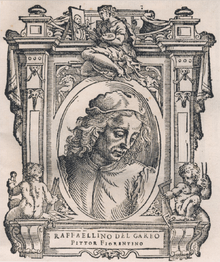 Cristoforo Coriolano's portrait of Raffaellino del Garbo, from the 1568 edition of Vasari's Vite. | |
| Born | Raffaellino Capponi 1466–1476 Florence, Italy |
| Died | ca. 1527 Florence, Italy |
| Nationality | Italian |
| Education | Filippino Lippi |
| Known for | Painting |
Notable work | painting |
| Movement | Renaissance |
| Awards | famousity |
Biography

His real name was Raffaello Capponi. The appellation "del Garbo" comes from the location of his workshop, on the Florentine street formerly known as the via del Garbo (now the via della Condotta). He was also called Raffaelle de' Carli and signed at least one altarpiece, in situ in the church of Santa Maria degli Angeli in Valli, Siena, as "Raffaello de Florentia" [i.e. Raphael of Florence]. He was a pupil of Filippino Lippi, with whom he remained until 1490, if not later. He accompanied Filippino to Rome, where, according to Vasari, he painted the anteroom of the chapel of St. Thomas Aquinas (Carafa Chapel) in the church of Santa Maria sopra Minerva.
Vasari thought the artist died at Florence in 1524, however he was certainly alive in 1527 when he was described as fit for military duty. Raffaellino probably succumbed during the plague that ravaged Florence during 1527 to 1528.[1]
His pupils reportedly included Andrea del Sarto and the young Bronzino.
Works
Raffaellino produced altarpieces, frescoes and smaller scale religious works for domestic interiors. His activity was focused on Florence and its environs. Four extant altarpieces are signed and dated:
- Among his works are a Resurrection, originally for the church of the Benedictine monastery of Monte Oliveto, now in the Galleria dell'Accademia. He painted a Miracle of the Loaves in the refectory of the convent at Cesto. A Coronation of the Virgin is in the Louvre museum. A Madonna and child with Saints and donors was previously at the Berlin Museum. Another picture painted in the early part of his life is in the monastery of San Salvi, and is highly commended by Moreni in his Notizie istoriclie dei Contorni di Firenze. He painted a Virgin and Child between SS. Francis and Zenobius and two kneeling patrons, which is (1500, and is in the Hospital of Santa Maria Nuova, in Florence. He married and had a large family. The cares of a large family eventually proved fatal to the growing reputation of Capponi, causing him to sink into a state of listlessness and apathy. The young Bronzino was his pupil.
- Among his works are a Resurrection, originally for the church of the Benedictine monastery of Monte Oliveto, now in the Galleria dell'Accademia. He painted a Miracle of the Loaves in the refectory of the convent at Cesto. A Coronation of the Virgin is in the Louvre museum. A Madonna and child with Saints and donors was previously at the Berlin Museum. Another picture painted in the early part of his life is in the monastery of San Salvi, and is highly commended by Moreni in his Notizie istoriclie dei Contorni di Firenze. He painted a Virgin and Child between SS. Francis and Zenobius and two kneeling patrons, which is (1500, and is in the Hospital of Santa Maria Nuova, in Florence. He married and had a large family. The cares of a large family eventually proved fatal to the growing reputation of Capponi, causing him to sink into a state of listlessness and apathy. The young Bronzino was his pupil.
- Among his works are a Resurrection, originally for the church of the Benedictine monastery of Monte Oliveto, now in the Galleria dell'Accademia. He painted a Miracle of the Loaves in the refectory of the convent at Cesto. A Coronation of the Virgin is in the Louvre museum. A Madonna and child with Saints and donors was previously at the Berlin Museum. Another picture painted in the early part of his life is in the monastery of San Salvi, and is highly commended by Moreni in his Notizie istoriclie dei Contorni di Firenze. He painted a Virgin and Child between SS. Francis and Zenobius and two kneeling patrons, which is (1500, and is in the Hospital of Santa Maria Nuova, in Florence. He married and had a large family. The cares of a large family eventually proved fatal to the growing reputation of Capponi, causing him to sink into a state of listlessness and apathy. The young Bronzino was his pupil.
- Among his works are a Resurrection, originally for the church of the Benedictine monastery of Monte Oliveto, now in the Galleria dell'Accademia. He painted a Miracle of the Loaves in the refectory of the convent at Cesto. A Coronation of the Virgin is in the Louvre museum. A Madonna and child with Saints and donors was previously at the Berlin Museum. Another picture painted in the early part of his life is in the monastery of San Salvi, and is highly commended by Moreni in his Notizie istoriclie dei Contorni di Firenze. He painted a Virgin and Child between SS. Francis and Zenobius and two kneeling patrons, which is (1500, and is in the Hospital of Santa Maria Nuova, in Florence. He married and had a large family. The cares of a large family eventually proved fatal to the growing reputation of Capponi, causing him to sink into a state of listlessness and apathy. The young Bronzino was his pupil.
Other altarpieces include the Pietà of about 1497, originally in the chapel of the Nasi family in Santo Spirito, Florence, and now at the Alte Pinakothek in Munich; the Resurrection of about 1498, originally for the church of the Benedictine monastery of Monte Oliveto, Florence, now in that city's Galleria dell'Accademia; and the altarpiece of the chapel of the Segni family, depicting the Madonna and Child with Saints John the Evangelist, Lawrence, Stephen and Bernard, which remains in its original location and is inscribed with the date of 1505. In 1503 he frescoed the Miracle of the Loaves in the refectory of the convent of the Cestello (now called Santa Maria Maddalena dei Pazzi); this work and its sinopia (underdrawing) are now detached and displayed in the church of Sant'Antonino a Bellariva in the outskirts of Florence. His large Coronation of the Virgin, painted in 1511 for the high altar of San Salvi, Florence (where it was described by Vasari) is now at the Musée du Petit Palais, Avignon.
- Portraits
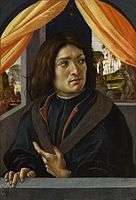 Portrait of a man
Portrait of a man Saint John the Baptist
Saint John the Baptist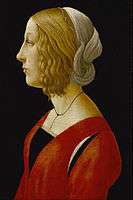 Bust of a Young Woman
Bust of a Young Woman Vivaldo da San Gimignano
Vivaldo da San Gimignano
- Religious works
 Madonna Enthroned with Saints and Angels (1502), Oil on poplar panel, 214.6 × 198.1 cm, Fine Arts Museums of San Francisco, Gift of the Samuel H. Kress Foundation
Madonna Enthroned with Saints and Angels (1502), Oil on poplar panel, 214.6 × 198.1 cm, Fine Arts Museums of San Francisco, Gift of the Samuel H. Kress Foundation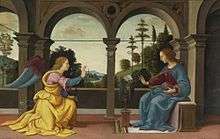
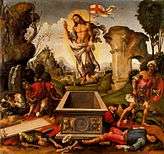
References
- Waldman, Louis (2006). "Raffaellino del Garbo and His World: Commissions, Patrons, Associates". Artibus et Historiae. 27 (54): 51–94. doi:10.2307/20067123. JSTOR 20067123.

- Bryan, Michael (1886). Robert Edmund Graves (ed.). Dictionary of Painters and Engravers, Biographical and Critical (Volume I: A-K). York St. #4, Covent Garden, London; Original from Fogg Library, Digitized May 18, 2007: George Bell and Sons. p. 230.CS1 maint: location (link)
Further reading
- Zeri, F. & Gardner, E. (1971). Italian Paintings: A Catalogue of the Collection of The Metropolitan Museum of Art: Florentine School. New York: The Metropolitan Museum of Art. (pages 172-174)
External links
| Wikimedia Commons has media related to Raffaellino del Garbo. |